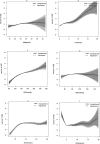Metabolic syndrome and its components with neuron-specific enolase: a cross-sectional study in large health check-up population in China
- PMID: 29643166
- PMCID: PMC5898352
- DOI: 10.1136/bmjopen-2017-020899
Metabolic syndrome and its components with neuron-specific enolase: a cross-sectional study in large health check-up population in China
Abstract
Objective: This study was aimed at investigating the relationship between neuron-specific enolase (NSE) and components of metabolic syndrome (MS).
Design: Cross-sectional study.
Setting: Chinese health check-up population.
Participants: 40 684 health check-up people were enrolled in this study from year 2014 to 2016.
Main outcome measures: OR and coefficient for MS.
Results: The percentage of abnormal NSE and MS was 26.85% and 8.85%, respectively. There were significant differences in sex, body mass index, drinking habit, triglycerides (TGs), high-density lipoprotein cholesterol (HDL-C), blood pressure and MS between low-NSE and high-NSE groups. In logistic regression analysis, elevated NSE was present in MS, higher body mass index, hypertriglyceridaemia, hypertension and low-HDL groups. Stepwise linear analysis showed a negative correlation between NSE and fasting blood glucose (FBG) (<6.0 mmol/L), and a positive correlation between NSE and TGs (<20 mmol/L), systolic blood pressure (75-200 mm Hg), HDL-C (0.75-2.50 mmol/L), diastolic blood pressure (<70 mm Hg) and FBG (6.00-20.00 mmol/L). Furthermore, MS was positively correlated with NSE within the range of 2.00-7.50 ng/mL, but had a negative correlation with NSE within the range of 7.50-23.00 ng/mL.
Conclusion: There are associations between NSE with MS and its components. The result suggests that NSE may be a potential predictor of MS. Further research could be conducted in discussing the potential mechanism involved.
Keywords: cross-sectional study; metabolic syndrome; neuron specific enolase.
© Article author(s) (or their employer(s) unless otherwise stated in the text of the article) 2018. All rights reserved. No commercial use is permitted unless otherwise expressly granted.
Conflict of interest statement
Competing interests: None declared.
Figures




Similar articles
-
[Associations between metabolic syndrome and reduced lung function in young people].Ter Arkh. 2017;89(10):54-61. doi: 10.17116/terarkh2017891054-61. Ter Arkh. 2017. PMID: 29171471 Russian.
-
Evaluation of the associations between changes in intraocular pressure and metabolic syndrome parameters: a retrospective cohort study in Japan.BMJ Open. 2016 Mar 24;6(3):e010360. doi: 10.1136/bmjopen-2015-010360. BMJ Open. 2016. PMID: 27013596 Free PMC article.
-
Waist-to-Height Ratio and Triglycerides/High-Density Lipoprotein Cholesterol Were the Optimal Predictors of Metabolic Syndrome in Uighur Men and Women in Xinjiang, China.Metab Syndr Relat Disord. 2015 Jun;13(5):214-20. doi: 10.1089/met.2014.0146. Epub 2015 Mar 17. Metab Syndr Relat Disord. 2015. PMID: 25781351
-
[Alterations of serum neurospecific proteins concentrations in patients with metabolic syndrome].Zh Nevrol Psikhiatr Im S S Korsakova. 2016;116(11):92-97. doi: 10.17116/jnevro201611611192-97. Zh Nevrol Psikhiatr Im S S Korsakova. 2016. PMID: 28091507 Russian.
-
Comparison of lipoprotein derived indices for evaluating cardio-metabolic risk factors and subclinical organ damage in middle-aged Chinese adults.Clin Chim Acta. 2017 Dec;475:22-27. doi: 10.1016/j.cca.2017.09.014. Epub 2017 Sep 29. Clin Chim Acta. 2017. PMID: 28969987
Cited by
-
Association between triglyceride-to-high density lipoprotein cholesterol ratio and three-month outcome in patients with acute ischemic stroke: a second analysis based on a prospective cohort study.BMC Neurol. 2022 Jul 16;22(1):263. doi: 10.1186/s12883-022-02791-2. BMC Neurol. 2022. PMID: 35842590 Free PMC article.
-
Expression patterns and clinical significances of ENO2 in lung cancer: an analysis based on Oncomine database.Ann Transl Med. 2020 May;8(10):639. doi: 10.21037/atm-20-3354. Ann Transl Med. 2020. PMID: 32566576 Free PMC article.
-
A Stress Syndrome Prototype Reflects Type 3 Diabetes and Ischemic Stroke Risk: The SABPA Study.Biology (Basel). 2021 Feb 18;10(2):162. doi: 10.3390/biology10020162. Biology (Basel). 2021. PMID: 33670473 Free PMC article.
-
Blood-Brain Barrier Biomarkers before and after Kidney Transplantation.Int J Mol Sci. 2023 Apr 1;24(7):6628. doi: 10.3390/ijms24076628. Int J Mol Sci. 2023. PMID: 37047601 Free PMC article.
References
-
- Forouzanfar MH, Alexander L, Anderson HR, et al. . Global, regional, and national comparative risk assessment of 79 behavioural, environmental and occupational, and metabolic risks or clusters of risks in 188 countries, 1990-2013: a systematic analysis for the Global Burden of Disease Study 2013. Lancet 2015;386:2287–323. 10.1016/S0140-6736(15)00128-2 - DOI - PMC - PubMed
MeSH terms
Substances
LinkOut - more resources
Full Text Sources
Other Literature Sources
Medical
